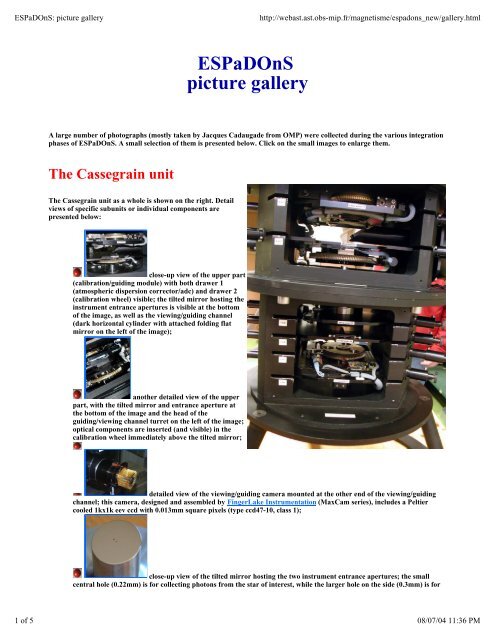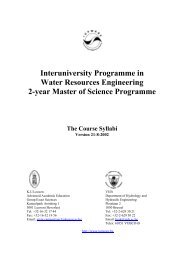CFHT operating manual - Homepage Usask
CFHT operating manual - Homepage Usask
CFHT operating manual - Homepage Usask
You also want an ePaper? Increase the reach of your titles
YUMPU automatically turns print PDFs into web optimized ePapers that Google loves.
ESPaDOnS: picture gallery http://webast.ast.obs-mip.fr/magnetisme/espadons_new/gallery.html<br />
ESPaDOnS<br />
picture gallery<br />
A large number of photographs (mostly taken by Jacques Cadaugade from OMP) were collected during the various integration<br />
phases of ESPaDOnS. A small selection of them is presented below. Click on the small images to enlarge them.<br />
The Cassegrain unit<br />
The Cassegrain unit as a whole is shown on the right. Detail<br />
views of specific subunits or individual components are<br />
presented below:<br />
close-up view of the upper part<br />
(calibration/guiding module) with both drawer 1<br />
(atmospheric dispersion corrector/adc) and drawer 2<br />
(calibration wheel) visible; the tilted mirror hosting the<br />
instrument entrance apertures is visible at the bottom<br />
of the image, as well as the viewing/guiding channel<br />
(dark horizontal cylinder with attached folding flat<br />
mirror on the left of the image);<br />
another detailed view of the upper<br />
part, with the tilted mirror and entrance aperture at<br />
the bottom of the image and the head of the<br />
guiding/viewing channel turret on the left of the image;<br />
optical components are inserted (and visible) in the<br />
calibration wheel immediately above the tilted mirror;<br />
detailed view of the viewing/guiding camera mounted at the other end of the viewing/guiding<br />
channel; this camera, designed and assembled by FingerLake Instrumentation (MaxCam series), includes a Peltier<br />
cooled 1kx1k eev ccd with 0.013mm square pixels (type ccd47-10, class 1);<br />
close-up view of the tilted mirror hosting the two instrument entrance apertures; the small<br />
central hole (0.22mm) is for collecting photons from the star of interest, while the larger hole on the side (0.3mm) is for<br />
1 of 5 08/07/04 11:36 PM

















